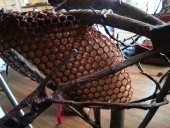Great thread! I notice that most of the posts here are debating the pit burn method vs top-lit updraft retort (TLUD) kilns. The pit method is simple and certainly the cheapest method - it costs nothing - but it necessitates digging the char out of your pit once complete, which is a deal-breaker for me. The TLUD is less efficient in terms of combustible materials, since nearly half of your wood generates heat only but no char. However, the TLUD promises to be more efficient in terms of time, as once you have a proven kiln and methodology you can set it and forget it. You don't even have to quench at the end, just come back the next day and collect your dry, cooled char. This intrigues me, and I may experiment with a TLUD in the future.
In the meantime, I have pursued a third option: a simple and cheap homemade take on the Kon-Tiki kiln. Like a name brand Kon-Tiki kiln, mine has a solid bottom and solid sides; you build the fire up in layers, but all air flows from the top down. I have built and operated mine fairly faithfully to this man's design and method:
Farm Life Australia
I've only burnt char once, but I would call that one burn a success. My observations:
- In the video, he is using 44-gallon drums (?) I used 55-gallon drums, which is a standard size here in North America.
- I actually use two identical 55-gallon kilns side by side. Both can be tended easily enough at one time, doubling the output per man-hour invested in each burn.
- Where I live, this design of kiln is easy to build with minimal capital investment. The only expense, besides a few metal-cutting disks for your angle grinder, are the steel drums themselves. I was able to obtain mine, used, for $10 each. Finding ones with the solid top and bungs, as opposed to a clamp-down removable lid, was somewhat difficult. Still, I obtained mine within a 1-hour drive.
- At first, burn a pilot fire with kindling and the bottom (larger) bung open. (Note in the video that the opening cut into the "top" of the kiln, as laid on the drum's side, is exactly opposite the larger bung, which is closest to the ground.) The extra airflow from the open bunghole will facilitate the burn. This pilot fire is meant only to heat up the kiln.
- Once hot, reclose the bung hole. I used a pair of tongs to manipulate the bung. It isn't easy to get that close to the hot, radiating kiln, but it is possible if one is careful! Then start layering additional fuel. With all airflow now restricted to top-down, the kiln is ready to make char.
- Unlike a TLUD, this style kiln requires continual, though not constant, maintenance. On average, I found myself adding wood and poking and prodding for about 20 minutes at a time, then taking 20 minutes to rest until the next layer. This varies with the size of wood you're burning; larger wood, longer rest between layers.
- What he says in the video is true: so long as the fuel is well seasoned - and you really don't want to try burning green wood in this type of biochar kiln (ask me how I know this) - it is amazing how little smoke is produced. This is because...
- The burn is hot! The BTUs it puts out are staggering. Next time, I will wear a face mask and a thermal apron to facilitate tending the fire without getting heat stroke, to which I thought I might succumb last time! It was also a very hot day to begin with. Poor timing on my part.
- To fill a 55-gallon kiln (or two, in my case) with char will take 4-5 hours burn time. This includes a solid 30 minutes to fill each barrel with quenching water using a garden hose. Sadly, this is one part of the process that does require double the time for my two side-by-side kilns, unless you have two people wielding two garden hoses at once.
- In the video, he doesn't show how he drains the kiln after quenching, but describes using a syphon (only because his kiln has a busted bung). Instead, when setting up your kiln, do so on slightly sloping ground and point the end with the bungs downhill. Then, draining the kiln is simple: unscrew the bottom bung and 95% of the water drains out quickly.
- Perhaps I'm just a noob. And as alluded to above, I had an unfortunate encounter half-way through my first burn with some unseasoned logs that nearly sent the burn off of the rails: they smoked to high heaven and seriously compromised the intensity of the fire for a while. Still, I was surprised at how many incompletely-charred logs I was left with. I still made huge amounts of good char, but there remains a nice little pile of too-heavy logs to add to my next burn. I hope to improve on this: next time, I will split all logs into smaller diameters to avoid a repeat of these results. I didn't think any of the logs were too large, but apparently it pays to be conservative.

 1
1





 1
1






 1
1








 2
2












 1
1




 2
2





 5
5





 7
7




 4
4




 8
8




 4
4




 5
5




 5
5




 2
2




 3
3




 4
4




 2
2









